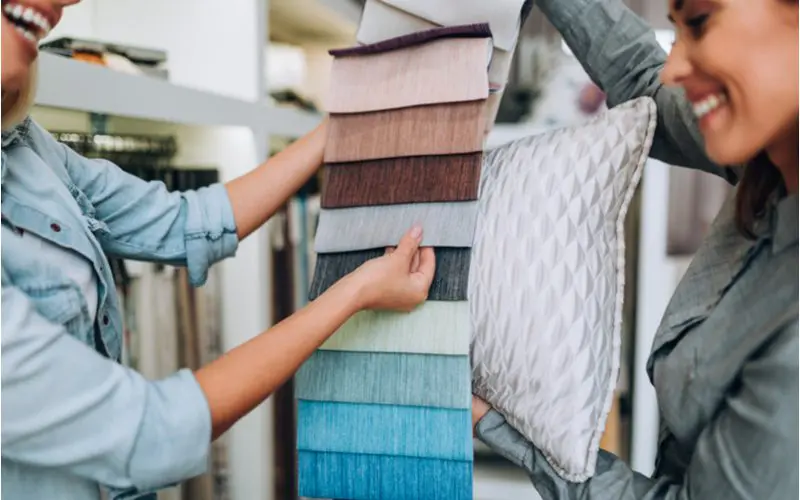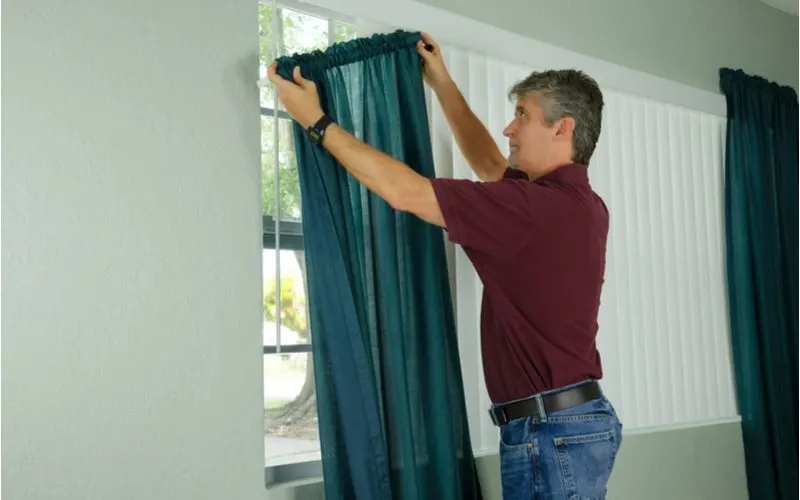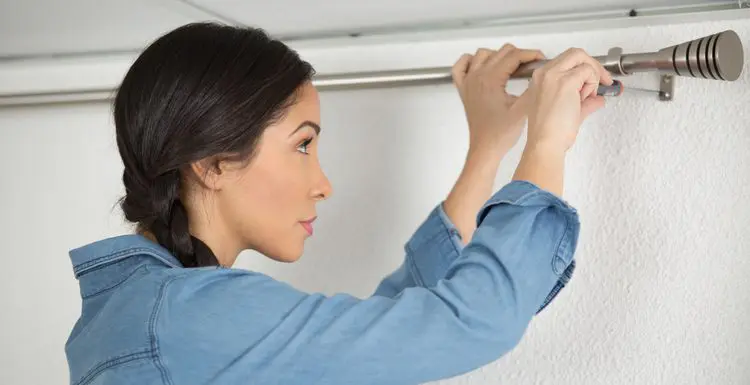Curtains are quintessential window treatments, and they have the uncanny ability to add final touches to any room’s décor.
The correct arrangement and combination of textures, patterns, and hanging panels can significantly impact the overall aesthetics of the living space.
Drapes and their importance often get neglected and overlooked, but this can change the room’s aura. Continue reading to discover the different methods and ways to hang your drapes or curtains.
What Are the Best Ways to Hang Curtains?

Syda Productions/Shutterstock
The traditional way and the most common way to hang drapery, specifically a rod pocket, is a casing or sewn-in pocket.
This pocket is positioned at the top of a drapery panel that slides over a rod and conceals it with relative ease.
When you hang drapery panels in this fashion, they have a casual look as they bunch very nicely.
Yet and still, there are many ways to hang your curtains; this includes the track method, which adds sophistication to any given space.
How Do You Hang Curtains?
The first decision you need to make is whether you want to have a curtain pole or a curtain track. Whichever you choose, both are efficient and convenient ways to hang your curtains.
Curtain Tracks vs. Curtain Rods
Curtain Track
Curtain tracks offer an exquisite way to hang curtains, mainly because you cannot see any track at all.
You’ll often find them layered in double and even triple tracks, combining voiles in bedrooms or blackout curtains with sheers.
These are a trendy choice thanks to the smooth operation of the tracking systems. Additionally, when curtains have to navigate smoothly around curved windows, curtain tracks are perfect for this application—think bay windows.
Curtain Pole
Unless you intend on using a pelmet or valance to cover the curtain pole, the rod will always be visible. These come in various sizes, and you can get them made from metal or wood.
Moreover, poles usually have something capping them off at both ends with a finial, or they have decorated stoppers to appear more elegant. These stoppers are tethered to the ends of the bar to ensure that the curtains remain in place.
The goal is to make sure that the curtains successfully frame the window, and you do so by installing the correct hardware to achieve this.
Convention says to allow for an extra ten percent of the rod on each side; however, heavier fabrics are sure to need more.
Unique Styles

hedgehod94/Shutterstock
Now that you’ve decided on how you’ll be hanging your curtains, take a look at some of these popular styles for inspiration on different ways to hang curtains:
Rod Pockets
The most traditional way to hang curtains in any room is to use rod pockets. The pockets are made of a casing sewn on the rear of the drapery panel at the top to conceal the rod beneath the curtain.
The rod pockets give the curtain fabric an easy way to run back on itself, creating a pocket that a rod can fit into perfectly.
Before choosing rod pockets, decide whether or not you’ll be opening and closing the curtains frequently. If the answer is yes, you may need to choose a different option because rod pockets are difficult to adjust.
Hanging Pins
This method of hanging curtains is elegant and creates a fitting look because it is the plastic thread that makes loops on the back of the curtain panel.
Hanging pins allow you to loop it through the plastic thread right before attaching it to the ring. This method creates a pristine look from the front of the curtain. Additionally, these pins allow you to move the drapes smoothly over the rod.
Pencil Pleat
This style of hanging curtains is popular in settings where you want an old-fashioned feel to the room. The pleats get gathered together, and they bunch at the top of the curtains.
This contemporary and elegant heading style requires tight and long folds at the top of the drapes. The long, consistent, neat folds on the drapes are similar to a pencil, which is where the name came from.
Goblet Pleat
Consider the goblet pleats for those who appreciate the more conservative and formal hanging style.
This style will blend in seamlessly if you have a Victorian or Georgian home. They have a detailed heading that resembles the pinch-pleated style of drapes.
Large homes with high ceilings favor this style of curtain, as the pleats are folded and tucked, and there’s an open design at the top. They also feature a cylinder-shaped cuff similar to a wine glass, and it follows an interlining pattern.
Hidden Tabs
An easy way to hang curtains is to use hidden tab panels to give them a pleated look. With hidden tabs, you can expect to see tabs or flat loops sewn alongside the curtain panel on top of the pole.
Hidden tabs give off the illusion that the drapery appears to be hovering on the pole. For anyone looking to circumvent curtain hanging hardware, the pleated look of hidden tabs is essential for such people.
Because the tabs have space between them, the pleating is sure to be even. Furthermore, hidden tabs are ideal for decorative curtains that you don’t plan on opening and closing too often.
This consideration is because the fabric of the curtain comes into direct contact with the rod, which makes it more cumbersome to move.
Curtain Rings
This style is another choice that is commonly used when hanging drapes. By utilizing small hooks, you can connect the rings to the curtains and place them on the rod.
Curtain rings are practical because the drapes can be removed and replaced seamlessly. They are available in various sizes, and you can typically choose from plastic, wood, or metal options.
Ring Clips
Heavily used in modern and traditional homes for hanging curtains are ring clips. Clipping the rings to the curtain panel on the top edge allows you to hang your drapery so that the rings can glide on the pole.
Moreover, if you wish to have more length, the ring clips provide an extra two inches of fabric that hangs a little beneath the curtain pole.
The best part about ring clips is that they move quickly, which means they can open your curtain panel every day without struggle.
Tie-Top Panels
This method can look very elegant but still works well as a casual highlight in a room without many accents and fixtures. It looks welcoming and rustic when you tie the strings at the top into tiny bows.
This style works best if you’re using a lightweight fabric. You tie the panels directly to the rod or curtain pole. No matter what room, this makes a statement.
Pinch Pleats
Pinch and goblet pleats look almost identical, but pinch pleats have added versatility. Pinch pleats consist of three creases formed at the top of the curtains.
They stay together by creating stitches shaped like fans. You can hang pinch pleat curtains on tracks or poles.
Sheer and Solids
This style is always a fun option, as you allow yourself to change the vibes in the room in an instant. Using solid and sheer curtains will enable you to adjust the privacy and lighting in the room at all times.
You get total light exposure if you open all of the curtains, or you can just pull the sheers together for a filtered light look. Lastly, you can pull all of them together if you want total darkness and privacy.
Things to Consider

Michael O’Keene/Shutterstock
Here are a few things to consider when you’re hanging your curtains, no matter which style you prefer:
- Height. You should always hang the curtains midway between the ceiling and the window casing. At the very minimum, they need to be two to four inches higher than the top of the casing.
- Length. The curtains should kiss the floor or hover right above the floor.
- Width. Your curtains should be four to ten inches past the window casing edge on either side of the window.
- Personal Style. The way the curtains hang and the style you choose should add to the overall feel and look of the sleeve they occupy.
Frequently Asked Questions
Here are the responses to the most commonly asked questions regarding ways to hang curtains:
How do you hang curtains without drilling holes?
There are multiple ways to hang curtains in your home without drilling holes or causing any damage to the walls. Using a wooden dowel is an elegant way to hang curtains using an adhesive bracket rather than drilling into the wall.
You can always choose to change the rods if they are too high or too low, and you don’t have to worry about damage. Additional ways to hang curtains without a drill:
- Tension rods
- Kwik-hang curtain brackets
- 3M command hooks
- Coat hooks
- Magnetic rods for metal doors
Should curtains go from ceiling to floor?
The answer to this question depends on the amount of space you have in the room. Take into consideration the perfect length, size, and width of curtains for the room. If they stop at an awkward distance above the floor, the ceilings seem lower.
For fuller-looking curtains, the panels should be double the width of the window itself. Don’t allow the curtains to lay entirely on the floor, but about one to two inches is sufficient.
Are motorized curtains worth it?
Yes, if you value privacy, security, and efficiency in your home, you may appreciate the benefits of motorized curtains.
These window treatments can also be integrated with automation systems so that the drapes can move in sync with the home’s music, lighting, and HVAC features. They also come in a variety of styles, lengths, and colors.
Which type of curtain is best?
The best choices for curtain materials are lime, faux silk, velvet, and silk fabric. They usually hang the best and don’t wrinkle as easily. The most durable option is faux silk because it doesn’t deteriorate as fast as genuine silk does, especially in sunny rooms.
Which color curtains are best?
Getting dark-colored drapes looks perfect against light-colored walls. That includes your gray, cream, white, ivory, smoky blue, and light tan walls. It makes an otherwise plain room color pop.
Never get dark curtains for dark walls, as it brings a cumbersome feeling into the room and feels oppressive. Dark doesn’t necessarily mean brown, black, or charcoal, but they can also be vibrant colors that are more inviting, such as red, blue, purple, and more.
So, Which of These Ways to Hang Curtains Will You Try?
With so many different ways to hang curtains in your home, it’s essential to keep in mind the look you want and the space you’re working with.
Choosing between tracks or rods is the first step before deciding how low you want the drapes to hang, whether you want decorative curtains, how far out they should come, and various other considerations.

